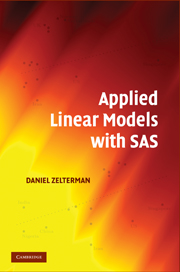Book contents
- Frontmatter
- Contents
- Preface
- Acknowledgments
- 1 Introduction
- 2 Principles of Statistics
- 3 Introduction to Linear Regression
- 4 Assessing the Regression
- 5 Multiple Linear Regression
- 6 Indicators, Interactions, and Transformations
- 7 Nonparametric Statistics
- 8 Logistic Regression
- 9 Diagnostics for Logistic Regression
- 10 Poisson Regression
- 11 Survival Analysis
- 12 Proportional Hazards Regression
- 13 Review of Methods
- Appendix: Statistical Tables
- References
- Selected Solutions and Hints
- Index
4 - Assessing the Regression
Published online by Cambridge University Press: 05 June 2012
- Frontmatter
- Contents
- Preface
- Acknowledgments
- 1 Introduction
- 2 Principles of Statistics
- 3 Introduction to Linear Regression
- 4 Assessing the Regression
- 5 Multiple Linear Regression
- 6 Indicators, Interactions, and Transformations
- 7 Nonparametric Statistics
- 8 Logistic Regression
- 9 Diagnostics for Logistic Regression
- 10 Poisson Regression
- 11 Survival Analysis
- 12 Proportional Hazards Regression
- 13 Review of Methods
- Appendix: Statistical Tables
- References
- Selected Solutions and Hints
- Index
Summary
How do we know if our linear regression is any good? We can take the results from Table 3.2 and test the null hypothesis that the regression slope is zero. That is, could this apparent regression have happened by chance alone, if x and y were really unrelated? What tangible benefit can we claim for performing a linear regression? The analysis of variance described in this chapter allows us to actually quantify the information gained when we examine a linear regression model. Even more importantly, is a straight line an appropriate summary for these data? Maybe there is a better explanation that describes a curved relationship between x and y. Finally, if there are remarkable exceptions to the linear pattern, how can we identify these observations? This chapter and the following use plots of the residual values to identify a large number of problems that can arise in fitting mathematical models to real data.
Correlation
The correlation coefficient is a single-number summary expressing the utility of a linear regression. The correlation coefficient is a dimensionless number between −1 and +1. The slope and the correlation have the same positive or negative sign. This single number is used to convey the strength of a linear relationship, so values closer to −1 or +1 indicate greater fidelity to a straight-line relationship.
The correlation measures the strength of a linear relationship.
The correlation is standardized in the sense that its value does not depend on the means or standard deviations of the x or y values.
- Type
- Chapter
- Information
- Applied Linear Models with SAS , pp. 75 - 89Publisher: Cambridge University PressPrint publication year: 2010



